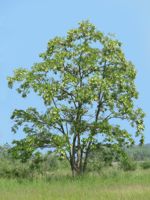Mon-Fri 9am - 5pm Mountain time
Black Locust vs Black Cottonwood
Robinia pseudoacacia
Populus trichocarpa
Black Locust is an attractive tree. Its distinctive leaves are made of about a dozen bright green leaflets. It also notable for its fragrant white flowers, which smell of citrus.
Black Locust can grow in many situations, but prefers dry areas with lots of sun. It is robust and is an excellent choice for establishing shade in dry, open areas.
Important note: Much of the Black Locust is toxic to humans and livestock, including seeds, bark, and leaves.
Black Cottonwood is the largest and tallest of the North American poplars. Named after its white, fluffy seeds with cottony hairs, this hardy tree produces sticky, fragrant buds and has a straight growth habit. Black Cottonwood needs ample moisture and nutrients to grow successfully to full height and are found in the Western provinces and the Yukon with BC being its heartland.

